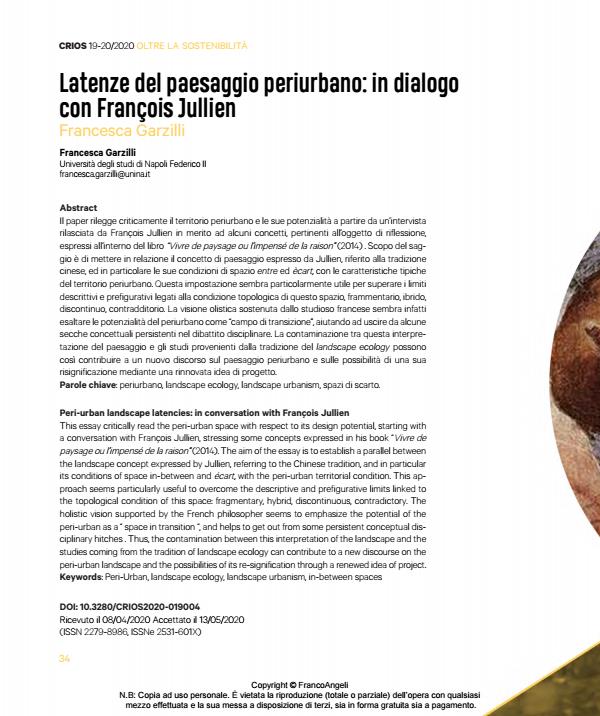Peri-urban landscape latencies: in conversation with François Jullien
Journal title CRIOS
Author/s Francesca Garzilli
Publishing Year 2021 Issue 2020/19-20
Language Italian Pages 12 P. 34-45 File size 327 KB
DOI 10.3280/CRIOS2020-019004
DOI is like a bar code for intellectual property: to have more infomation
click here
Below, you can see the article first page
If you want to buy this article in PDF format, you can do it, following the instructions to buy download credits

FrancoAngeli is member of Publishers International Linking Association, Inc (PILA), a not-for-profit association which run the CrossRef service enabling links to and from online scholarly content.
This essay critically read the peri-urban space with respect to its design potential, starting with a conversation with François Jullien, stressing some concepts expressed in his book "Vivre de paysage ou l’impensé de la raison" (2014). The aim of the essay is to establish a parallel between the landscape concept expressed by Jullien, referring to the Chinese tradition, and in particular its conditions of space in-between and écart, with the peri-urban territorial condition. This ap¬proach seems particularly useful to overcome the descriptive and prefigurative limits linked to the topological condition of this space: fragmentary, hybrid, discontinuous, contradictory. The holistic vision supported by the French philosopher seems to emphasize the potential of the peri-urban as a - space in transition -, and helps to get out from some persistent conceptual dis¬ciplinary hitches . Thus, the contamination between this interpretation of the landscape and the studies coming from the tradition of landscape ecology can contribute to a new discourse on the peri-urban landscape and the possibilities of its re-signification through a renewed idea of project.
Keywords: Peri-Urban, landscape ecology, landscape urbanism, in-between spaces
Francesca Garzilli, Latenze del paesaggio periurbano: in dialogo con François Jullien in "CRIOS" 19-20/2020, pp 34-45, DOI: 10.3280/CRIOS2020-019004